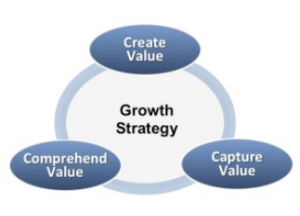 I am reading a lot about the concept of value creation recently, it answers everything but tells us so often nothing about how it is made up or it is truly present. It seems to have that same ‘heady vaulted position’ as innovation in that we all talk far more about the ‘promise’ of it, we want it but still are not prepared to put the real effort into it to make it happen.
I am reading a lot about the concept of value creation recently, it answers everything but tells us so often nothing about how it is made up or it is truly present. It seems to have that same ‘heady vaulted position’ as innovation in that we all talk far more about the ‘promise’ of it, we want it but still are not prepared to put the real effort into it to make it happen.
So let me try and explain my thoughts on value creation. So what is behind value creation? What drives it? What will tell us this is an organization where value creation seems to well invest in, nurtured, built and protected?
So what is value creation?
Value creation is highly dynamic, it is going on all the time and can increase, decrease or transform, in different ways, when you exploit your different capitals that will be in constant change and adjusting to reflect your organization’s business activities and eventual outputs. This is when you can begin to see the value created by the use of deploying all the capitals to build new growth and what I call “stock” that along with “flow”. I loved this explaination of the two.
Value is not just from within, it is the links our organizations are constantly making with others, in the interactions, relationships and the combining of the activities. The important need is to manage the stocks and flows of the capitals
The role of all the capitals is crucial to understand, they create or destroy value. It is the constant flow between all the capitals deployed that makes up the value creation process.
Our management within our organizations needs to know where this real value creation resides.
 Understanding all the makeup of capitals needs to be approached in practical ways.
Understanding all the makeup of capitals needs to be approached in practical ways.
The place to focus is on recognizing the material components of what is making up the specific value creation aspects that will provide benefits that have been captured, understood, maintained and then enhanced for the additional value creation
Clearly, the ultimate objective is to enhance the organization’s abilities in the longer-term to appreciate the growth strategy. The more we know as outsiders of the value creation process the more likely this will attract greater investment. Often this is determined by the final product, service or business model outcome.
Today we lack the measures to judge longer-term adequately, that this is enough in organizations. We are judging them on their innovation activity going through the immediate pipeline and that judgment often lacks the real makeup of the application of the different capitals, invested in the knowledge that can provide the sustaining growth- today we are far too geared on immediate expectations and those are locked up in the short-term.
It is becoming critical to understand our sources of knowledge, it gives us the unique capital that differentiates one Enterprise from another. The intangibles today are up to 80% of the value assigned to the (market value) worth. Managing these intangibles is critical to our future. Yet, we still have a very poor grasp of how to capture these and drive this knowledge capital. That needs to change.
It is the Knowledge and Innovation combined that make the firm competitive. There is this positive correlation between these two. One amplifies the other, one deepens the other in the connected understanding. The basis for this comes from both human and artificial intelligence. As we learn to capture from both we build our capital base and strengthen our future potential. We make ourselves more sustainable as well as increasingly adaptive.
The greater the stock of knowledge understanding will increase the potential flows of innovation and this “powers” the future value creation.
Greater engagement or not?
We can leave this knowledge building to the management, just sit back as investors or consumers and simply expect increased dividends and new products. We actually need to dig a little deeper and push management to inform us we will not enjoy many of those nasty surprises when the results fail to materialize. The argument is that the investors, the stakeholders within a business, need to understand the business logic far more, to make a more informed decision to continue to invest or partner with a particular organization. That logic comes partly from the abilities to create value
Knowing the successful generation of all the intangible values and their transformation into tangible forms and how this is systematically being harnessed tends to confirm the realization of the business goals or what the possible risks are.
Organizations are certainly fairly reluctant to discuss these except behind closed doors to selected investment parties in their investor’s briefings. Making these more visible leads to greater accountability and to be ‘accountable’ you need to understand the makeup of your capitals.
The present incentive for business organizations to become more vocal in explaining their business models, their process for value creation and offering more insight on all their capitals is their need to grow and that comes from investors wanting to invest and customers wanted to buy something that has a sustaining future!
Exposing the softer side of value creation is the key.
 The need is to understand value creation is often coming from the ‘softer’ side, those often intangibles that remain hidden for the real value enhancing aspects of a business but are constantly at work, generating knowledge, understanding and new thinking. These need drawing out more.
The need is to understand value creation is often coming from the ‘softer’ side, those often intangibles that remain hidden for the real value enhancing aspects of a business but are constantly at work, generating knowledge, understanding and new thinking. These need drawing out more.
The real capital that contributes to value creation is coming from knowing answers to these questions offered below.
Many of these can be reported upon and that would enhance the understanding and attract investment. By thoughtfully measuring and reporting upon these builds that external confidence that the business is focusing on the sustaining values relevant to its goals and growth objectives.
Just work through this list of aspects of value creation that we should be gaining insight into:
* The ways an organization is setting about combining and utilizing networks and relationships
* How are they actively advancing their creative and innovation capabilities and competencies? Are there specific frameworks and approaches.
* The ways they are actually seeking out in explicit ways that deepening of customer understanding
* The purposeful ways that reputation is being protected, quality is being enhanced
* How are the brands protected, enhanced and improved to add increasing value
* How they are capturing new knowledge internally and the ways this flows and gets translated into new value through specific value enhancing stores
* How the focusing on social issues and values is contributing to society and equally underpinning their value into both local and global communities
* What are the plans and intent to link social, environment and harness the intellectual capitals, to enhance and strengthen society and the organization’s linkage, and the outcomes being achieved?
* Where they are recognizing, strengthening and exploiting the value chain linkages
* Providing a greater depth of explaining and extending the organizations skills and capacities to learn and absorb, through advancing specific capabilities, and deepening capacities.
* How they continue to build loyalty and trust and what aspects need repairing or renewing due to difficult decisions or changing circumstances, showing a clear pathway of achieving this responsiveness and flexibility.
* How and where does innovation fit, for achieving the growth perspectives and discussing any shortfalls, through prescribed or alternative actions? Are you building a common sense of innovation purpose?
* Are there explicit innovation competencies, processes, and governance actively being managed, that provide support to the activities being undertaken and being consistently risk assessed?
* What is the risk appetite for innovations? How is this managed? How is this explained and celebrated?
* Lastly, what they are exploring in the different forms of evaluation, experimentation and ongoing assessment to ‘measure’ the real underlying asset wealth of the organization.
This is their learning journey and its growing value to all associated with this to achieve that better visibility into our organizations, Better outcomes and a greater relationship between investors and the organization needs to be achieved. I think it is possible but it is a journey many are reluctant to travel. Value often gets locked up, caught in the internal world of the one organization and so often never becomes value creation.
We need to talk about what makes up “value creation”.
Value Creation is really important to know about. Where is it coming from, what is being put into place to nurture, develop and allow its creation to evolve and spread, so it has the ability to attract more understanding for value and creation? The more we open up our thinking and ideas the more we can build from this. That openness offers so much more value creation possibility yet we don’t talk about it, we simply generalize it like a “buzz word”
There is a growing need to know where the value creation is coming from and what the management of our organizations is doing to protect and enhance it. Knowing the makeup of the material capitals that form into a value creation is so important to this. We should talk of value creation in specific and detailed ways. That gives those listening confidence it is being taken seriously and not just given lip service.